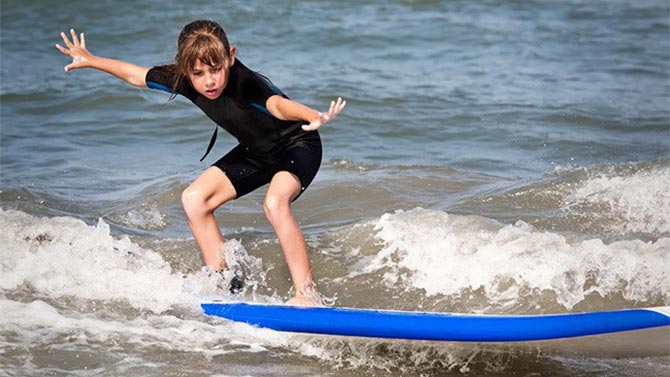Some of the most important safety tips for surfing with kids in Fort Lauderdale include taking lessons from a professional, familiarity of ocean landscape and knowing surfing etiquette.
Growing up in or around Fort Lauderdale has a tendency to attract even the youngest kids to surfing. We’ve seen some pretty small kids catch some pretty impressive waves! As long as a child is physically and mentally prepared to surf, it’s never too early to start.
6 Important Safety Tips For Surfing With Kids
#1. Take Lessons From A Professional
If your child is interested in learning how to surf, enroll them in classes with a trained professional. This allows them to learn all of the basics as well as the most important safety tips out on the water. This also helps ensure the gear they are using adequately fits them.
Camp Live Oak offers one of the safest ways for kids to learn how to surf, learn more about our surf camp here: https://contourbeta.com/clo2024/site/surfing/
#2. Know How To Avoid Dangers Lurking In The Water
There are certain things you don’t want to run into out in the water, like jellyfish or other surfers. Taking lessons with a professional helps familiarize surfers to potential risks as well as teaching them how to avoid risks as best as possible.
There is very specific surfer etiquette practiced out in the water in order to give everyone a fair chance to catch waves without getting injured by flying boards and reckless surfers. Lessons provide you with the established ocean rules, unwritten but very real. In fact, there’s a word for surfers that don’t comply with etiquette—it’s “Kook.” Kook does not refer to a beginner but instead anyone that is all out disrespecting surfing etiquette.
Without warning from an experienced surfer some surfing dangers can be very unexpected, like fire coral. Fire coral can cause extreme burning if you come into contact with it. That’s because it’s not really coral, but instead a type of sea creature found on the edges of reefs because they can stand more turbulent waters.
#3. Know What Size & Shape Waves You Can Handle
Beginner surfers are not looking to catch the same waves as experienced surfers. You want the size and shape of the waves to be just right; otherwise surfing can get dangerous pretty quickly. Even small waves can be incredibly powerful, with one cubic foot of water weighing in around 62 pounds.
Beginners should seek out crumbling waves, which are less dangerous than hollow waves. You can find crumbling waves where the ocean floor gradually extends deeper. As a result, the water has more time to slow its roll and reduce its strength before it crashes on shore.
Hollow waves form off the coast where the ocean floor quickly goes from shallow to deep. Hollow waves are shorter and harder to catch, plus they have hard breaks that lead to an increased potential for serious wipeouts.
#4. Avoid Currents
Rip currents are dangerous and should be avoided. Sometimes it’s good to teach kids how to surf in shallow water where there are very short and non-powerful rip currents. This gives kids a feel for what rip currents are and how they work. Understanding rip currents and how to get of them is essential because no matter how careful you are, there’s always the chance of getting caught up in one if you spend a lot of time in the water.
#5. Know The Ocean Landscape
If an area is devoid of all surfers, that doesn’t necessarily mean it’s a good place for a beginner to start. Sure, no one is in the way, but why is that? Certain parts of the ocean have a lot of rocks and boulders built up along the ocean floor. These sorts of ocean roadblocks can really trip up surfers and cause a lot of physical damage, to both surfers and surfboards.
Sometimes you can’t actually see a submerged rock or builder from shore but sometimes you cannot. That’s why it’s important to ask around and know what’s beneath the water before surfing somewhere new.
#6. Take Swimming Lessons
Knowing how to swim is paramount to staying safe if, or rather when you fall off your board. Swimming lessons should start in a pool where kids can learn all of the strokes and how to move in water. After kids master the pool, it’s time to learn how to swim in the ocean. If you know how to swim in the ocean you’ll be less fearful of falling off your board, making the whole experience far more enjoyable.
Calling All Kids & Teens: Come Surf With Camp Live Oak!
We offer a safe and fun way for kids to learn how to surf from step one or improve upon their surfing skills. Learn more here: https://contourbeta.com/clo2024/site/surfing/

